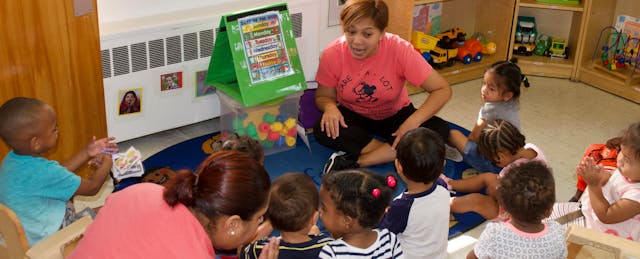PHILADELPHIA — On most days at the Care-A-Lot Learning Center, Yaribel Mercedes-Perez’s first moments of calm come several hours in, when students are settled in for naptime.
Until then, from 7:30 a.m. to noon, it’s a whirlwind of singing, dancing, playing, reading, diapering, feeding and, at points, wrangling the 13 toddlers she helps care for. It’s not for the faint of heart, though she manages to bring to it a great deal of attention and enthusiasm.
At 12 p.m., after all the children have eaten and are lying down during naptime, Mercedes-Perez and the two other teachers sit down to have their own lunch. By that time, they have collectively covered enough material—days of the week, seasons, shapes, colors, numbers, letters, animals, hand-washing and more, through songs, books and activities—to make anyone’s head spin.

So when the kids are sprawled asleep on their mats and the silence has set in, the teachers are due for a respite. Only, for Mercedes-Perez, that sacred time is cut short. The 25-year-old teacher is herself a student—an apprentice, in fact—and must use that quiet period to crank through some homework, study for an exam, start drafting an essay or take a quiz.
Mercedes-Perez is one of 36 child care workers across Philadelphia accepted into the inaugural class of a first-of-its-kind apprenticeship program for early childhood educators. Like the other apprentices in the program, Mercedes-Perez has a Child Development Associate (CDA) Credential, the first step of career development and a requirement for early childhood educators in many states. Launched in 2017, the apprenticeship program puts teachers in the field with a CDA on a fast-track to earn their associate degree, with up to four pay raises delivered along the way. The program covers most tuition, books and transportation costs for educators as well.

Providing child care is a job that requires immense skill, patience and energy. But many cities lack the training or support to prepare people for the challenge. That’s why the Philadelphia apprenticeship program exists—to better prepare the city’s early childhood workforce to interact with young children, whose brain development from birth to age five is critical for long-term learning and success.
At the same time, the program aims to increase wages and diversity in a workforce beset by low pay and high turnover rates that range from 26 to 40 percent every year.
To date, the program has graduated about 10 apprentices out of its initial cohort, with another 22 expected to graduate between December and fall 2020—Mercedes-Perez among them.
As an apprentice, Mercedes-Perez participates in a model of training that provides on-the-job learning and instruction, culminating in a credential that is recognized nationally. For decades, apprenticeships have been a mainstay of trades such as plumbing and carpentry, and more recently in healthcare and IT. But the Philadelphia program is one of the first efforts to apply the model to early childhood education.
To do so, the program relies on a host of funding and programmatic partners, including employers themselves.

In the Philadelphia program, apprentices earn an associate degree in addition to a nationally recognized credential. The program awards nine credits for those who have a CDA credential and another nine credits from on-the-job learning, which, for Mercedes-Perez, is led and monitored by Cherry Bernardino, the lead teacher in Care-A-Lot’s toddler classroom and Mercedes-Perez’s designated coach. The remainder of her 62-credit degree comes from courses taken through the Community College of Philadelphia—either in-person classes held during the evenings or online whenever she can find the time.
Throughout the apprenticeship, Bernardino meets weekly with Mercedes-Perez to discuss and assess her progress toward the more than 220 competencies every apprentice must develop and master in the classroom. The competencies draw on those established by the National Association for the Education of Young Children (NAEYC), the premier professional association and accrediting organization for early childhood educators. These competencies include everything from providing space and materials for children to develop fine motor skills, to offering positive guidance such as listening and reinforcing.
Located in the Grays Ferry neighborhood of South Philly, Care-A-Lot is licensed to serve up to 36 students, the vast majority of whom are from low-income families. In the toddler classroom, where Mercedes-Perez works with children who range in age from 12 to 35 months, the cost of care is $210 to $235 per week. In the preschool classroom, where children are 3 to 5 years old, the weekly rate is $195.
Of the 31 children currently enrolled at Care-A-Lot, all but two or three of their families are using child care subsidies from the government to send their kids to the center, says Lynda Calvano, director and owner of Care-A-Lot. Families must meet income and citizenship requirements to qualify for a subsidy. If a child care provider chooses to accept the subsidy, it can charge families the difference between the subsidy amount and the full rate. In Pennsylvania, families using subsidies must pay a weekly co-pay of $5 or more.
Calvano initially introduced Mercedes-Perez to the apprenticeship program in 2017, when Philadelphia’s 1199C Training & Upgrading Fund was recruiting its first cohort, and has come to count on her as a reliable employee. More importantly, Calvano wants to ensure that the young teacher has the support she needs to remain in the field. “A skilled worker is important” in early learning, Calvano says. “Some people are just natural teachers, and Yaribel is a natural.”

Jameelah Jones, an apprentice and assistant teacher at the Parent Infant Center in West Philadelphia, has also been described as “a natural.” After many stops and starts over the course of 16 years, due to raising two children as well as battling breast cancer, Jones never got her associate degree—until the apprenticeship program came along. “It was a blessing,” Jones says, “because I’ve been working toward my associate degree for so long. If it wasn’t for the program, I don’t think I would’ve really seen an end in sight.”
Kharma Hicks, the infant/toddler program coordinator at the Parent Infant Center, had encouraged Jones, who is 52 years old, to apply for the program when it was first launching. “We’re investing in our teachers. We’re proud of them. We want them to be able to get their degrees,” Hicks says. “Some of them had stopped taking classes earlier, for whatever reasons—life happens—and this allowed them to get back in the program with a lot of support, tutors, compensation, and coming out debt-free.”
Child care is mentally and physically demanding, but the compensation hardly reflects that. In Pennsylvania, the average wage for child care workers was $9.71 per hour in 2017. That’s slightly higher than the state’s minimum wage of $7.25 per hour but still only half of the state’s median wage overall, according to calculations performed by the Center for the Study of Child Care Employment at the University of California, Berkeley.
To address this reality, the program guarantees apprentices up to four wage increases. Mercedes-Perez and her employer, Calvano, agreed to a $.50/hour incremental raise, for a total increase of $2.00 per hour by the time she graduates in spring 2020. Unlike the majority of offerings of the apprenticeship program, the wage increases are paid for by the employers.
At the same time, apprentices don’t have to take out loans to pay for their degrees. “Our apprentices graduate debt-free, which is huge for this population that is underfunded and underpaid,” says Ta’Mora Jackson, the early childhood education apprenticeship coordinator for the Training Fund, the organization that administers the program.
Without the program, Jackson adds, further credentialing is costly, laborious and, in some cases, downright unrealistic because of the time and resource demands it places on early childhood educators. But the apprenticeship program puts the goal of a degree and the possibility of career growth—and the higher pay that comes with it—well within reach.
Upstairs at Care-A-Lot, while the children are asleep, Bernardino pulls out a three-inch, three-ring binder filled with evaluations, notes and competency trackers from her meetings with Mercedes-Perez. Bernardino receives her own training and mentorship on how to be an effective coach in this program. Like all coaches, she receives a small stipend to compensate for the time she allots each week to her role.
Bernardino reflects on what she observed earlier that morning, recalling the teacher-guided story time Mercedes-Perez led. “She is so good with storytelling, she can become so animated,” Bernardino says. “She’s able to stretch the spoken words of this children’s book and explain what is happening in the story.”
She also points to the relationship Mercedes-Perez has developed with each of the children in her care. “That’s a big thing, that she’s able to establish that rapport,” Bernardino says, because she is then able to “see and foresee what’s going to happen next after a behavior.”

Bernardino refers to an exhaustive list of competencies laid out in a spreadsheet that she made herself. One page in the binder includes two competencies that Mercedes-Perez was exhibiting with the children during story time: “Read books about animals and their adaptation to the changing seasons” and “Compare and contrast animals.”
Mercedes-Perez’s community college coursework often reinforces what she’s learning at work and from her coach. For one assignment, she observed her students and assessed their personality types. This fall, Mercedes-Perez is taking a course on special education, which she’ll be able to use in her classroom, particularly to support two students who require additional attention.
It’s no small undertaking for employers to sponsor an apprentice. Employers must pay the agreed-upon salary increases. In addition, they must accommodate scheduling issues the program causes. Sometimes apprentices have to leave work up to an hour early to get to their night classes on time. In other cases, apprentices use their release time throughout the day for schoolwork, as Mercedes-Perez does with her lunch period and nap time.
That's difficult in an industry where being present is paramount for compliance and safety: If a teacher is not in the classroom, a director must often find someone else to take over to maintain required teacher-student ratios. If they fail to do so, they may face licensing violations, resulting in fines and other penalties.
“It’s definitely a heavy lift for an industry that is often always operating at a deficit, funding-wise,” Jackson says. “We were able to sell the program [to employers] as an investment in their workforce.”
Calvano, who recently agreed to sponsor a teacher in her center’s preschool classroom for the September 2019 apprentice cohort, agrees.“You’re making an investment in the staff, in the hopes that you achieve less staff turnover,” she says.
But two apprentices is a big financial commitment, and Calvano acknowledges that. Would she continue to participate in the program indefinitely? “You know, you have to just see how things go,” she says. “This business is like a roller coaster. My enrollment and income fluctuates.”
For the apprentices, many of whom have either graduated or are counting down the weeks until graduation, the program has been a boon. And it may yet have more to offer: Five of the graduates have already enrolled in bachelor degree programs, at Drexel University or Arcadia University, which have both partnered with the Training Fund and agreed to accept all the credits apprentices bring from their associate degrees. “That is amazing,” Jackson says, “because previously, if you got an associate degree and tried to go to a four-year university, there were so many prerequisites you’d basically have to do it all over again.”
Mercedes-Perez, who is eagerly approaching her graduation in the spring, is one of the apprentices already eyeing the next step in her education. Jones, who walked in the graduation ceremony in May and has just one more course to pass, is another.
“Years ago, I didn’t have a goal to continue for my bachelor’s, but now I do,” Jones says, laughing. “So hopefully—I don’t know—maybe the master’s is next.”


